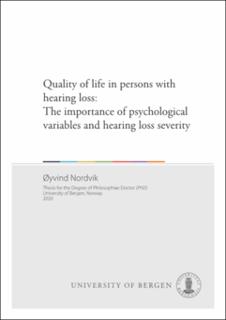| dc.contributor.author | Nordvik, Øyvind | en_US |
| dc.date.accessioned | 2020-02-28T14:21:20Z | |
| dc.date.available | 2020-02-28T14:21:20Z | |
| dc.date.issued | 2020-02-14 | |
| dc.date.submitted | 2020-01-02T10:38:14.625Z | |
| dc.identifier | container/05/d8/ee/e6/05d8eee6-cb42-46a5-9afa-22d1e589713e | |
| dc.identifier.isbn | 9788230848982 | en_US |
| dc.identifier.isbn | 9788230864289 | en_US |
| dc.identifier.uri | https://hdl.handle.net/1956/21447 | |
| dc.description.abstract | Hearing loss (HL) is a prevalent condition, representing health and social challenges for a substantial number or of people globally. Up to 15% of the world’s adult population is estimated to suffer from HL. As most people with HL suffers from age related HL, i.e. presbyacusis, the growing proportion of older people in the population, will lead to a substantial increase in the number of persons with hearing loss in the near future. In addition to the effect this will have on each individual’s life, it also represents huge social consequences. The overall objective of this thesis was to investigate the relationship between HL, general/generic and communication-specific (Health Related) Quality of Life ((HR)QoL). As supporting aims, distress, personality and choice of coping in HL patients was also investigated. In paper I, we aimed to further develop the Abbreviated Profile of Hearing Aid Benefit (APHAB) questionnaire for the self-assessment of communication ability. We investigated the psychometric properties of the Norwegian version of the questionnaire applied to controls and a group of persons with various degrees of HL seeking HA. The findings indicate that the questionnaire is a valid measure of communication ability in both quiet and adverse listening conditions for participants with and without HL. This questionnaire was applied in paper III and paper IV. Paper II presents a systematic literature review of studies investigating generic QoL in patients with HL. As an additional aim, we also included studies that addressed distress, mood, anxiety and HL. The findings in this review suggests that HL is associated with reduced generic QoL. However, the findings were equivocal, with some studies suggesting a strong relationship between HL and QoL, while others found no such relations. We also found that hearing aids (HA) seems to improve general QoL within the first year and that HL is a risk factor for distress. Conducting a systematic literature review developed our understanding of the field, and the findings enabled us to develop methods and hypothesis applied in paper III and IV. In the third paper we studied the relationship between general QoL, the APHAB response pattern and HL. The study found that the QoL level in persons with HL seems to be close to what seen in the general population, but higher than what is seen in many chronic serious diseases. Patients with unilateral HL reported slightly worse social function and more fatigue than patients with bilateral HL. Self- assessed communication ability correlated with general QoL scores. We also found that best pure tone average, but also cognitive and physical QoL function were associated to APHAB scores. This study concludes that general QoL scores among HL individuals seems to be relatively close to what have been reported in the general population. In paper IV we investigated the importance of personality and choice of coping on QoL, distress and reported communication ability in persons with HL. Significant correlations were found between APHAB, HRQoL, distress scores on the one side and personality and coping style on the other side. The results suggests that employed coping style, distress/HRQoL and personality were closely associated to each other in this patient group. Patient-reported communication ability was associated to PTA (best ear) and personality. In overall conclusion, general QoL among patients with HL seeking HA seems to be close to population levels. Distress scores may be slightly elevated compared to population norms. QoL and distress scores and interestingly APHAB scores seems also to depend on personality scores. | en_US |
| dc.language.iso | eng | eng |
| dc.publisher | The University of Bergen | eng |
| dc.relation.haspart | Paper 1: Heggdal, P. O. L., Nordvik, Ø., Brännström, J., Vassbotn, F., Aarstad, A. K.H., & Aarstad, H. J. (2018). Clinical application and psychometric properties of a Norwegian questionnaire for the self-assessment of communication in quiet and adverse conditions using two revised APHAB subscales. Journal of the American Academy of Audiology, 29(1), 25-34. The article is not available in BORA due to publisher restrictions. The published version is available at: <a href=" https://doi.org/10.3766/jaaa.16102" target="blank">https://doi.org/10.3766/jaaa.16102</a> | en_US |
| dc.relation.haspart | Paper 2: Nordvik, Ø., Heggdal, P. O. L., Brännström, J., Vassbotn, F., Aarstad, A. K.H., & Aarstad, H. J. (2018). Generic quality of life in persons with hearing loss: a systematic literature review. BMC Ear, Nose and Throat Disorders 18(1): 1. The article is available at: <a href="http://hdl.handle.net/1956/19270" target="blank">http://hdl.handle.net/1956/19270</a> | en_US |
| dc.relation.haspart | Paper 3: Nordvik, Ø., Heggdal, P.O.L., Brännström, J., Hjermstad, M., Aarstad, A.K.H., Aarstad, H.J. (2019). Quality of Life in Persons with Hearing Loss: A study of patients referred to an audiological service. International Journal of Audiology, 58(11), 696-703. The article is not available in BORA due to publisher restrictions. The published version is available at: <a href=" https://doi.org/10.1080/14992027.2019.1627010" target="blank"> https://doi.org/10.1080/14992027.2019.1627010</a> | en_US |
| dc.relation.haspart | Paper 4: Nordvik, Ø., Heggdal, P.O.L., Brännström, J., Aarstad, A.K.H., Aarstad, H.J. (2019). Personality, Choice of Coping, Quality of life, Distress in persons with Hearing Loss: A cross-sectional study of patients referred to an audiological service. The article is not available in BORA. | en_US |
| dc.rights | In copyright | eng |
| dc.rights.uri | http://rightsstatements.org/page/InC/1.0/ | eng |
| dc.title | Quality of life in persons with hearing loss: The importance of psychological variables and hearing loss severity | en_US |
| dc.type | Doctoral thesis | |
| dc.date.updated | 2020-01-02T10:38:14.625Z | |
| dc.rights.holder | Copyright the Author. All rights reserved | |
| fs.unitcode | 13-24-0 | |
